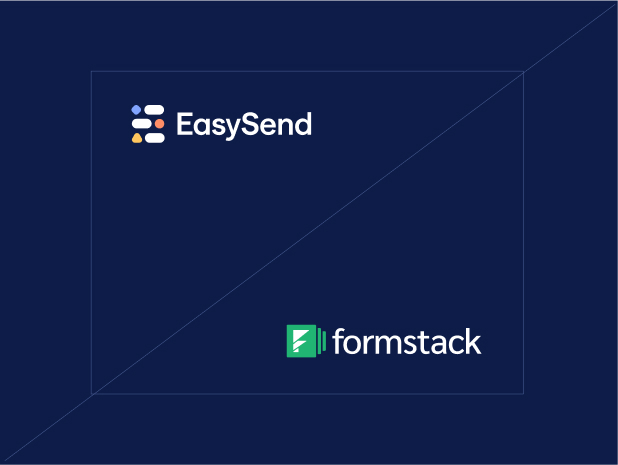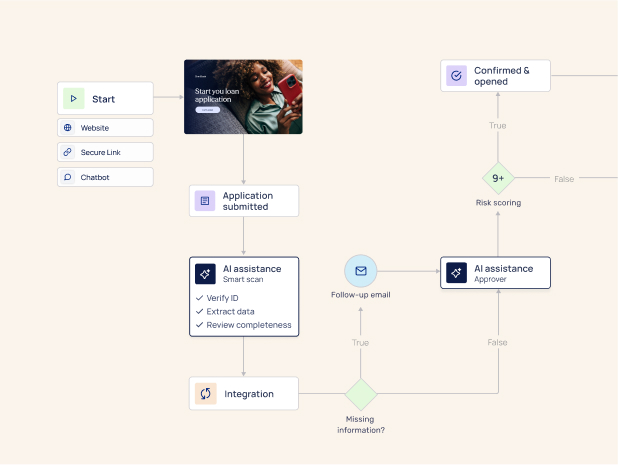TL;DR
Static loan forms and email attachments create friction and compliance risk. With EasySend, lenders can design AI-powered, Salesforce-connected digital journeys that adapt to borrower input, validate uploads instantly, support multi-party signing, and sync clean data back to core systems. The result: faster onboarding, fewer errors, and a seamless borrower experience.
Loan teams don’t struggle because they lack forms; they struggle because the journey around those forms is fragmented. The fix is a guided, AI-powered flow that knows what to ask, who to ask, and when, while syncing clean data and files to your systems with full auditability. Below is a pragmatic, end-to-end playbook aligned to EasySend’s strengths (AI Journey Builder, AI PDF Converter, multi-party eSign, Salesforce integration) so you can ship in days, not months.
1) Define the outcome and guardrails
Before screens or fields, decide what “done” means.
- Business goal: e.g., “Reduce time-to-approval from 7 days to 48 hours for SMB term loans ≤ $500k.”
- Scope: loan products covered, jurisdictions, languages, and signer roles (borrower, co-borrower, guarantor, advisor, underwriter, compliance).
- Non-negotiables: compliance standards (SOC2/ISO/GDPR/HIPAA), auditability, accessibility (WCAG), and real-time CRM/LOS sync.
- KPIs: completion rate, average time to complete, % files auto-validated on first pass, manual rework rate, SLA to underwriting.
You’ll use these to make trade-offs later (e.g., soft vs. hard validations).
2) Inventory what you already have
Collect your current PDF packets, checklists, disclosures, and email templates. In EasySend, import them with AI PDF Converter to auto-extract fields and a first pass at steps. This gives you a workable baseline instead of a blank canvas.
3) Generate the skeleton with AI
Open AI Journey Builder and describe the ideal experience in plain language. For example:
“Create a 6-step loan document journey: (1) Borrower profile prefilled from Salesforce; (2) Employment & income with rules for salaried vs. self-employed; (3) Document uploads (pay stubs, tax returns, ID) with freshness and file-type checks; (4) Co-borrower invite; (5) eSignature: parallel for borrowers, serial for internal approvals; (6) Review & submit. On submit: update Opportunity + custom Loan__c, attach files with metadata, alert underwriting.”
You’ll get an editable, mobile-ready scaffold in minutes.
4) Model participants and permissions
Map who does what, in what order.
- External roles: borrower, co-borrower/guarantor.
- Internal roles: loan officer, credit/underwriting, compliance.
- Access: role-based visibility; field-level permissions for sensitive data.
- Signing modes:
- Parallel for borrower & co-borrower to speed turnaround.
- Serial for internal approvals that must follow sequence.
- Sign Together for assisted sessions when applicants need live help.
- Parallel for borrower & co-borrower to speed turnaround.
In EasySend, assign roles to steps and fields; the UI and routing adapt automatically.
5) Design the dynamic checklist
Replace static “upload everything” lists with rules that tailor requirements per applicant.
Think in three layers:
- Product rules: loan type and amount dictate the base document set.
- Profile rules: employment type, entity type, geography add or remove items.
- Risk rules: score bands or red flags trigger enhanced documentation.
Examples (expressed conceptually; implement with EasySend conditions):
- If amount > $250k, require audited financials; else reviewed or management-prepared.
- If employment = self-employed, request Schedule C/K-1 and last two years’ returns.
- If geography = CA, inject state-specific disclosure block.
- If risk = high, add bank statements for 6 months instead of 3.
The journey should show only what’s relevant, and explain why each item is needed.

6) Get the uploads experience right
Uploads make or break completion. Build for real life:
- Formats & limits: allow PDF/JPG/PNG/HEIC; sensible size caps; total cap to prevent stalls.
- Mobile first: background upload queue, visible progress, retry on flaky networks, auto-compression for images/video.
- Freshness & completeness: flag pay stubs older than N days; ensure all pages of tax returns are present.
- Duplicate detection: hash files to prevent re-uploads; mark “already received.”
- Clarity: microcopy like “Upload your most recent two pay stubs (last 60 days).”
- Preview & replace: let borrowers see thumbnails and swap a file without starting over.
All of this is point-and-click in EasySend’s upload components and validation rules.
7) Add smart validations without dead-ends
Use inline checks to catch issues early, but avoid stranding borrowers.
- Field patterns: SSN/EIN, email, phone.
- Cross-field logic: if stated income < threshold, ask for additional explanation; if business age < 24 months, request alternate docs.
- Temporal rules: incident/issued dates can’t be in the future; documents must be within freshness windows.
- Soft vs. hard stops: prefer “soft warnings” with a route-to-review option for edge cases.
This balances data quality with a humane experience.
8) Orchestrate eSignature and collaboration
Wire the signing flow to your real approval paths.
- Borrowers: parallel signing to minimize waiting.
- Internal approvers: serial steps (credit → compliance → final).
- Assisted completions: enable Sign Together so agents can guide complex applicants in one live session.
Because eSign is native in EasySend, you can mix signing modes in one journey with a single audit trail.
9) Map data and files to systems
No more “uploaded to a folder, then emailed.”
- Salesforce: map fields to Opportunity, custom Loan__c, related BeneficialOwner__c, and Activities. Persist the journey session ID on records for traceability.
- LOS/DMS: create or update the Application; attach files with preserved filenames and metadata (size, hash, EXIF timestamp when present).
- Events: fire webhooks to Slack/Teams for underwriting queues; update Monday.com if you run an ops board.
Use EasySend’s native mappers for Salesforce and connectors/APIs for your LOS.
10) Build notifications that move the process forward
Replace “nudge” emails with purposeful messages.
- Borrower: a “what’s left” digest with deep links to the exact missing step; SMS reminder for high-value items.
- Co-borrower: a personal invite that explains their role and the two or three items they must complete.
- Team: underwriter alert with a compact summary card (requested vs. received, flags, time in step).
Write notifications like UI: short, specific, actionable.
11) Engineer compliance into the flow
Don’t bolt it on later.
- Consent: versioned disclosures; jurisdiction-specific language injected by rule.
- Security: role-based access, least privilege, encryption in transit/at rest.
- Audit: immutable event log of every view, change, upload, and signature.
- Accessibility & localization: WCAG-aware components; locale-aware dates and numbers; translated labels where needed.
- Retention: policy-driven purge/archival of evidence files.
EasySend’s platform certifications (SOC 2, ISO 27001, GDPR, HIPAA) cover the envelope; your process rules cover the particulars.
12) Test like a borrower, ship like a product team
Run a tight UAT sprint before go-live.
- Happy paths: salaried vs. self-employed; with and without co-borrower.
- Edge cases: large file on weak mobile, partial sessions, timezone quirks, name changes.
- Accessibility: keyboard navigation, screen reader labels, contrast checks.
- Systems: verify every mapped field and attachment lands on the correct records with the correct metadata.
Launch gradually (one product, one region), watch the dashboards, and iterate weekly.
13) Measure, learn, and optimize
Post-launch, make the journey a living asset.
- North-star metrics: completion rate, time-to-submit, % first-pass approvals, manual rework.
- Funnel insights: step-level drop-offs; most-failed validations; most-requested documents.
- A/B ideas: order of steps (uploads before financials?), microcopy variants, different reminder cadences, assisted vs. self-serve for high-risk segments.
- Policy changes: when underwriting rules evolve, update the conditions, not the whole journey.
Because EasySend is low-code, these changes are same-day edits, not projects.
A simple blueprint you can reuse
Journey structure (example):
- Welcome & consent → 2) Borrower profile (prefill) → 3) Employment & income (branch) → 4) Document uploads (dynamic checklist) → 5) Co-borrower invite & sign → 6) Review, eSign, submit → 7) Confirmation & next steps.
Data model (starter):
Loan__c (type, amount, term, region, risk_band)
Borrower__c (KYC fields, contact)
BeneficialOwner__c (repeatable)
Document__c (type, filename, size, hash, freshness, uploaded_by, journey_session_id)
AI prompts you can paste into EasySend:
- “Convert this loan doc packet into a mobile-friendly, multi-step journey with dynamic checklist by employment type and loan amount.”
- “Add rules: if loan_amount > 250000 require audited_financials; if employment = self_employed request Schedule_C and K-1.”
- “Create eSign flow: borrowers parallel; internal approvals serial (credit → compliance).”
- “Map fields to Salesforce: Opportunity, Loan__c, BeneficialOwner__c; attach files with metadata; include journey_session_id on all records.”
Common pitfalls (and how to avoid them)
- Front-loading everything: keep step one to identity + essentials; branch later.
- Over-strict validations: prefer soft warnings and route to review; don’t block progress for fixable issues.
- Treating uploads as a black box: store metadata and link every file to the claim/application.
- Forgetting assisted paths: some borrowers need Sign Together; make it available where drop-off is high.
- Shipping without metrics: instrument from day one; you can’t optimize what you can’t see.
The takeaway
Automating loan document intake isn’t about “adding an upload widget.” It’s about designing a dynamic interaction layer between your customers and your systems: adaptive, compliant, multi-party, and measurable. With EasySend’s AI tools, you move from PDFs and inboxes to a living journey that collects, validates, and routes everything automatically, all while keeping Salesforce and your LOS perfectly in sync.
.jpg)




